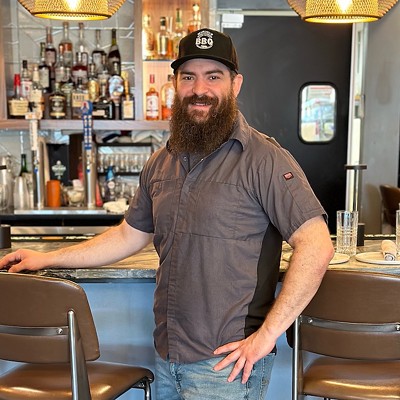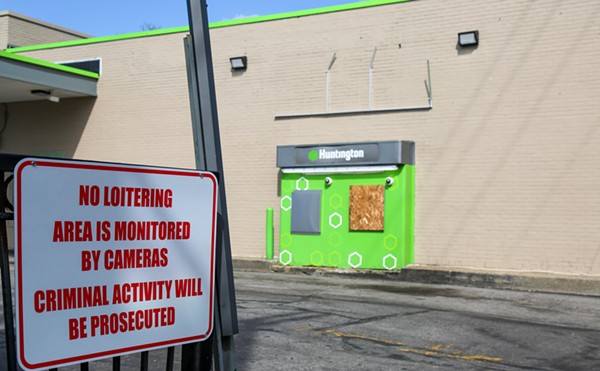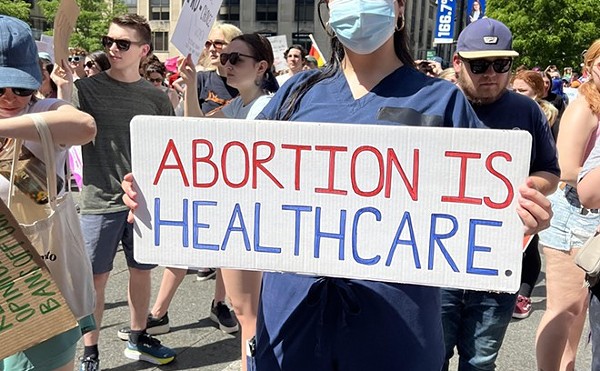What the boss keeps in his office can give you a clue about his personality. Look in and around the offices of Jakprints co-founders Jacob Edwards and Dameon Guess, and you'll see skateboards and screen-printed concert posters by famed Cleveland artist Derek Hess. There are electric guitars bought at a charity auction — one painted by their friend Hess, the other by Alex Grey, who did album art for Tool. Feast your eyes on the likes of these, and you might rightly assume that the guys who run the place love them some art and some rock and roll.
For the uninitiated, Jakprints is the Cleveland printing company whose principal means of marketing for years was a garage band's tour van. They grew out of a second-floor apartment in Willoughby to become a major player in the industry in less than a decade — all the while staying true to their roots. The company now has 120 employees and 69,741 customers worldwide. In May, Jakprints was honored by Harvard Business School's Initiative for a Competitive Inner City as one of the top 100 U.S. companies doing business in the urban core. Not bad for a couple of guys who didn't get past 10th grade.
Edwards and Guess were raised in separate school districts, but they both had an early sense that the classroom might not go so well. Edwards attended Kennedy Alternative School in Eastlake, a place for kids who were at risk of dropping out.
"There were about ten kids in the class, and everyone was like a crazy metalhead wreck — except for me," he says. "I was the only normal kid. But somehow I was failing."
A class clown in his earlier years, Guess got to Kirtland High and found the only thing that went right was art class and the projects that came as a result: He drew a comic strip for the paper and made posters for school activities. After school he had jobs in restaurants and mowing lawns.
"Somehow I ended up at Jacob's house, skateboarding," recalls Guess — certain that it happened, but not so certain how he got there.
It was in high school that Edwards launched his first band, appropriately called Primitive. Edwards played bass, his brother Isaac played drums, and a friend rounded out the trio on guitar. When the opportunity arose to record at a studio in Kansas City, they figured it'd be OK to miss two weeks of class. But the school told Edwards if he went ahead with the plan, he shouldn't bother coming back.
"My mom and dad were incredibly supportive of our music, and they figured having a high school degree wasn't going to be the thing that determined whether we succeeded or not." So away they went.
On the road, Edwards learned how struggling bands worked and how they paid their bills. His own band — whose Helmet-like alt-metal sound eventually morphed into indie rock — changed its name to Sheilbound, after a song title on Primitive's lone seven-inch record. They toured the Midwest and both coasts in a Chevy Astro van and lived a life of couch-surfing and ramen-fueled adventure, just like the hundreds of bands they encountered along the way. All of them needed fliers, postcards, and posters to promote their shows. And they all wanted to sell screen-printed T-shirts, so that even when they weren't onstage, there would be something to declare their existence.
But most bands had a common problem: They didn't have the money or demand for large enough quantities to make printing cost-effective. Edwards had learned how to print on clothing from his father, who made shirts for his construction company. He made his first screen-print setup out of wood and some Speedball craft supplies, printing tiny runs of 25 and drying them in the oven of his Willoughby kitchen. He fronted the money and split the proceeds with his bandmates.
By the time Guess was 18, he moved to Gainesville, Florida, where his father had settled. Dad set him up with a transparent blue iMac G3, and soon he was doing freelance design for printers while building waterfalls for a landscaper. A year later his brother moved to town, and the two started a heavy but melodic band called Sansara, which was described by writers as a cross between Tool and U2. They put out a self-titled cassette and played some shows. Bassist Guess had been in Gainesville about five years when his old skateboarding buddy came through town on a tour with Sheilbound.
"That's when we had some of those first conversations about what we'd do in the future," says Guess. Edwards wasn't fully employed as a printer yet, but his company, Jak Entertainment, was doing a little business. He handled an order of T-shirts for Sansara, and when Edwards had orders that called for Guess's graphic skills, both of them could get paid.
Within a year, Guess moved back to Ohio, to an apartment on Coventry. He got his GED and enrolled at Cleveland State, thinking an art degree would do him some good. But work got in the way.
"I'd come home from school and have four or five freelance jobs with deadlines that pay," he remembers, "and I'm supposed to draw an apple and some sandals for class." Guess quickly found that his on-the-job training had put him far ahead of what was being taught in class. His college years lasted six days.
At the time, Jak Entertainment had an office on Lakeshore Boulevard in Euclid. Edwards built Guess a plywood desk and invited him to work there. "That was the final enticement to move in," says Guess. Edwards was using a Frankensteined computer cobbled together by a friend.
"I was slightly in business when Dameon came along," says Edwards. It was 2001, and Jakprints, at long last, was born.
Most of their work was T-shirts or postcards and stickers for bands. Sheilbound continued to tour, with their song "Lake Erie Fever" becoming a crowd favorite. And everywhere they went, conversation among bands naturally gravitated toward merchandise. T-shirts, stickers, and CDs were where the money was — way more than the performances themselves would pay. Edwards passed out fliers to every band he met and brought back orders. He knew exactly what they needed — he was one of them, after all.
Soon, Jakprints needed more room, so they moved to larger space on Lost Nation Road in Willoughby and bought their first four-color screen-print setup, which allowed them to lay down different colors of ink in turn, assembly-line style. They printed the T-shirts themselves and brokered the postcards and stickers to other companies.
Evidence of Sheilbound and Sansara is slim these days, given that their heyday preceded the dawn of MySpace and Facebook. Collectors might find a Sheilbound seven-inch record, or a few posters designed by Derek Hess for shows the band opened at the Euclid Tavern.
But that same technological cusp that left Edwards' and Guesses' bands in obscurity served Jakprints well. The company never invested in the expensive equipment and now-obsolete skills that defined commercial printing less than 15 years ago. For them, graphic design was always a digital process, so they bypassed the transition that bogged down so many competitors.
As the continuing digital revolution made CDs virtually obsolete, T-shirts, hats, and other merchandise became primary revenue streams for a lot of bands. As Edwards says: "You can't download a T-shirt."
By 2003 Jakprints opened a satellite office in the old American Greetings creative studios on West 78th Street. It spared customers the drive to Willoughby and gave the company a presence in an energetic community of artists whose businesses fed off one another. Derek Hess, 1300 Gallery, Alternative Press magazine, Hardcore Marketing, Little Jacket Design Studios, and several artists and photographers all had space there.
The building's landlord, Dan Bush, recalls that the arrival of Marty Geramita and Derek Hess with 1300 Gallery was catalytic. "The day after their first art show opened, the Jakprint guys were talking to me about opening a small marketing office there. A month later they were looking for 4,500 square feet. I showed them the leakiest, crappiest corner of the building that I had at the time — AG's old ten-bay loading dock. The roof leaked, it was cold, damp, rotted. They, in their typical fashion, said, 'Yeah, we'll take it.'"
By then, Jakprints had five employees, all of them friends. Besides Edwards and Guess, there was Jeff Weisenberg, who came with screen-printing experience and now runs the company's apparel division. Bill Rupnik, who came from a customer-service background, is now VP of product development (he also runs William Rupnik Gallery on East 40th). Nick DiTomaso, a former hip-hop artist who once hired Jakprints to print his "Ill Eagle" stickers, quit his call-center job at Progressive Insurance to join a company he thought fit his personality better. He is now director of operations.
"Their work ethic is freakish," says Geramita, who manages Derek Hess and his Strhess line of apparel. "They would stay up 48 hours working constantly, sleeping in their office, not take showers. My whole life I've prided myself on being a hard worker. But they worked so hard they made me feel bad."
These days the company handles screen printing for Strhess, which includes T-shirts, hoodies, and other items featuring graphics by Hess.
"I've done tons of traveling with those guys," says Geramita. "I'd be out drinking and having a good time, they'd be out hitting the streets, passing out fliers, shaking hands. I can say that 1300 Gallery and Derek Hess wouldn't have become what they were without them. Their hard work has paid off for us."
If hard work and timing played key roles in the rise of Jakprints, knowledge of their customer base didn't hurt. Sheilbound was still performing then, and Edwards always pushed his business when he was gigging with other bands. Jakprints' first growth spurt happened when its owners opted to stop being just the middleman.
"We were outsourcing about $100,000 worth of printing per quarter," says Guess. "Insightfully, Jacob said to me one day, 'We should get our own press.'"
They eventually found a bank to make them a loan for a $750,000 press. They filled the space beneath the loading dock with enough concrete to support it, and they hired about 30 more friends.
Soon after, Jakprints outgrew the space on West 78th Street. So they ponied up $850,000 for their current building on Chester Avenue in 2005. Except for a dose of color from the banners out front, it's the kind of low brick building you wouldn't even notice driving by.
Inside, though, the place is bustling, from the steady stream of customers upfront, to silkscreen presses that look like giant octopuses with T-shirts moving around their tentacles, to printing presses that turn forklift pallets full of paper into equal amounts of promotional fliers. During an office tour, Rupnik explains that Jakprints is heavily invested in efficiency — laying out jobs like a puzzle, so that multiple projects can fit on a single sheet of paper with minimal waste.
In the finishing room, young hires who clearly share the founders' work ethic operate folding machines and massive shears that turn stacks of paper into booklets. Most of the workers look like they're just out of high school. In fact, one look around the plant, and it would be easy to assume that all the young people who haven't left Cleveland are working at Jakprints.
And they're a musical lot. Edwards says he learns every month that somewhere among the company's 120 employees, another new band has gotten together.
"We've worked not at all intentionally to hire young people," says Guess. "But in our years of refining the process, we've found that if you don't like music, art, or skateboarding, it's probably not going to work out here."
As it turns out, these passions are translating to money. According to Harvard's Initiative for a Competitive Inner City, Jakprints had $13.5 million in revenue in 2008 and was growing at an average rate of 33 percent per year. Just three years after buying the Chester Avenue building, they leased the one next door to house a spin-off called Indiemerch, an apparel merchandising company that is Jakprints' major clothing customer. Run from a California office by Edwards' brother and Sheilbound bandmate Isaac, Indiemerch prints and distributes T-shirts and other apparel for bands, handling the process from beginning to end and paying the artists a royalty, just like record companies do.
The trappings of Jakprints' success are just beginning to show, though not in flashy ways. They just bought their first conference table — secondhand, refinished by a guy in the shop. Edwards considers it a milestone that all 15 of their sales reps can finally sit around the same room for a meeting.
Guess, meanwhile, revels in their escape from online obscurity: "You can finally type 'Jackprints,' and Google will ask you if you meant 'Jakprints,'" he says.
They've printed for Jägermeister, MTV, the Rock Hall, Red Bull, Hot Topic, and multitudes of other clients (including Scene), but about 50 percent of their business is still directly with bands — from nationally known artists like Akron's Black Keys, Above This Fire, Clutch, Gwar, and Black Dahlia Murder to unknown, nascent ensembles ordering small runs of T-shirts to sell on tour — just like Sheilbound used to do.
The CEOs are a little older now; Edwards is married, and he and his wife have a seven-month-old daughter. Edwards and Guess mostly get around not on skateboards these days, but in the Hyundais they both drive — their "roller skates," in Jakprints parlance. But they do still skate, and they still play music; both are regulars on the local concert and gallery scenes.
But they're not sure whether they'd do it all the same way again. Just as Edwards says dropping out of school "did nothing" for him, Guess knows he took a risk. "We have succeeded and have great accomplishments behind us, but should this falter or fail, we really have nothing to fall back on," he says.
When Guess recently went to collect their prize at Harvard, he couldn't help but notice that he was surely the lone dropout surrounded by MBAs. "We have no real accreditation or anything like that," he says. "God forbid I ever have to look for a job."
It doesn't seem he'll have to worry anytime soon. They steadily reinvest in Jakprints, from embroidery machines to greater printing capacity. And they are always looking for the next wave of evolution. They may not yet know exactly what it will be, but that's not a problem.
"You go throw yourself down a handrail and see what it's like," says Edwards, invoking an eminently Jakprints metaphor. "That's what it is to be an entrepreneur. You're taking a risk. It takes balls."
Send feedback to [email protected].













